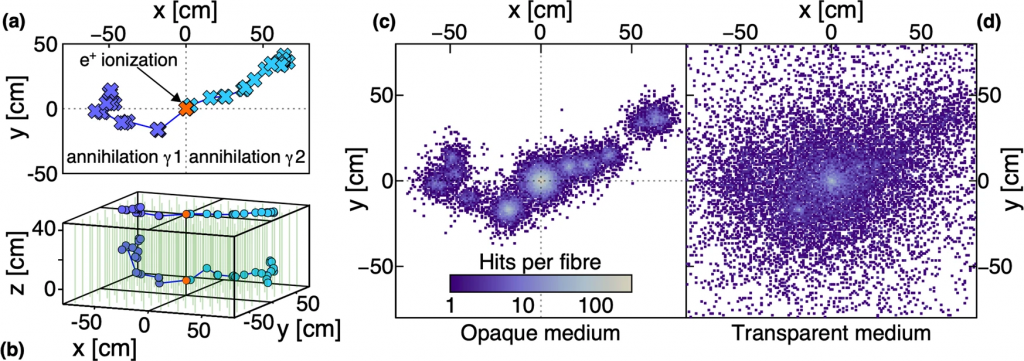LiquidO fundamental particle detection technology relies on the exploitation of opaque media for light detection. Here opaque medium refers to the use of material(s) causing very strong elastic scattering of light, order 1millimetre mean-free path with minimal absorption. The main mechanisms used by LiquidO’s scattering are the Mie and Raleigh light scattering, however, internal reflections may also be used. A common example of a highly scattering medium is milk – an emulsion of small droplets of fat (≤5%) in water – as opposed to water, being an easy transparent medium. While gas media is possible, most LiquidO R&D so far relies on liquid and solid media with oil or water as the main basis.
The main goal is to ensure a lossless (i.e. elastic) light scatter, as opposed to inelastic scattering or even reflections, which have long been commonly used in technology for detector segmentation. Even excellent reflective materials (≥95%) may lead to large losses of light due to a large number of reflections to contain light within a reduced volume. LiquidO exploits materials that can produce light (i.e. optical photons) upon the energy deposition of fundamental particles, such as scintillation and Cherenkov light emission. However, LiquidO may exploit other light emission mechanisms, as its detection functioning is not attached to the light production mechanism exploited. So, scintillation and Cherenkov are exploited so far simply because they are the most abundant and common in nature and existing technology.

The light produced is therefore effectively bent by the strong scattering, thus forming light balls around every energy deposition, leading to the phenomenon pioneered by LiquidO referred to as the stochastic confinement of light. This is the trivial consequence that each optical photon describes a random walk trajectory relative to its production point. This is illustrated using a sub-atomic positron (e+; antimatter) energy deposition imaging from our Nature’s Communication Physics 4 273 2021. Scattering during light detection has historically been minimised, or even avoided, in traditional detectors since this leads to the effective increase of the attenuation length, once folded with some unavoidable light absorption effects. LiquidO detection efficiency is the outcome of the competition between detection and absorption, so light must be detected as close as possible to the origin using wavelength-shifting optical fibres before the light is absorbed. This implies a high-density array of fibres, whose arrangement may lead to different topological features. An optimised LiquidO detector is characterised by its excellent collection efficiency (typically ≥90%, depending on the fibre array density), which is the probability for any generated optical photons to hit a fibre before absorption. The overall detection mechanism is however typically limited by the trapping efficiency of fibres (≤25%) and the quantum efficiency of the photosensors (≤60%) used for the ultimate light detection, once trapped within the fibres.
Thanks to its stochastic light confinement, LiquidO enables the imaging of fundamental particle energy deposition(s) without the need for any mechanical segmentation, typically leading to detector volume sub-divisions into pixels or any sub-structure alike. The size of the light ball is proportional to the mean free path of the scattering length, the density of the fibre array and the amount of light per ball, hence the energy deposition and light yield. The pitch of the fibre lattice traversing the medium must be at least proportional to the light ball dimension to ensure optimal sampling of the event topology is possible.
